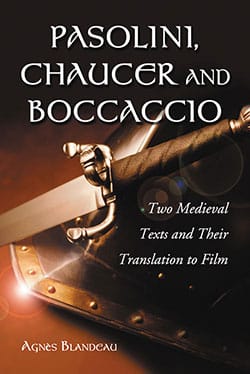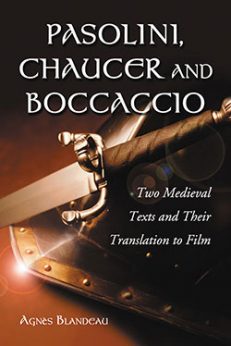Pasolini, Chaucer and Boccaccio
Two Medieval Texts and Their Translation to Film
Original price was: $39.95.$31.99Current price is: $31.99.
In stock
About the Book
Pier Pasolini’s “trilogy of life” is a series of film adaptations of major texts of the past: The Decameron, The Canterbury Tales, and One Thousand and One Nights. The movies demonstrate a film author’s acute aesthetic sensibility through a highly original cinematic rendering of the sources. The first two films, closely examined in this book, offer a personal, purposefully stylized vision of the Middle Ages, as though Pasolini were dreaming Boccaccio’s and Chaucer’s texts through the filter of his “heretic” consciousness. The unusual poetic visualization of the source works, which could be described as irreverent cinematic homage, has the potential to renew the traditional reading of such literature.
This book shows how cinema becomes an alternative form of storytelling. It first studies the two films in detail, putting them in perspective within the trilogy. Next it interprets them, recounting misinterpretations and expounding upon Pasolini’s ideological perception, and defends the oft-criticized adaptations. Finally, it discusses how the films represent innovation over strict adaptation. Appendices offer charts with information on the narrative structures of the films and the correspondences between them.
About the Author(s)
Bibliographic Details
Agnès Blandeau
Format: softcover (6 x 9)
Pages: 218
Bibliographic Info: appendices, notes, bibliography, index
Copyright Date: 2006
pISBN: 978-0-7864-2247-0
eISBN: 978-1-4766-2087-9
Imprint: McFarland
Table of Contents
Preface 1
Introduction 5
I. THE FILM: AN ALTERNATIVE FORM OF TELLING, ANOTHER
TEXTUAL ARCHITECTURE, AND DIFFERENT MEANINGS
1. I Racconti di Canterbury: The Film Text of The Canterbury Tales 11
2. Placing I Racconti di Canterbury in Perspective with The Decameron 49
3. Il Fiore delle mille e una notte: The Last Panel of the Triptych 86
II. THE ADAPTATION: A CLOSE ENCOUNTER OF THE THIRD KIND
4. The Shock of Pasolini’s Trilogy 89
5. A Trans-semiotization: The Subversive Intention in I Racconti di Canterbury 97
6. Eloquent Pictures 111
7. A Defense of Adaptation 140
Conclusion 155
Appendix 1: Chart Showing Narrative Structure of I Racconti di Canterbury in Text and Film 165
Appendix 2: Chart Showing Narrative Structure of The Decameron in Text and Film 167
Appendix 3: Chart Showing Echoes and Correspondences Between I Racconti di Canterbury and The Decameron 170
Notes 175
Bibliography 191
Index 205





